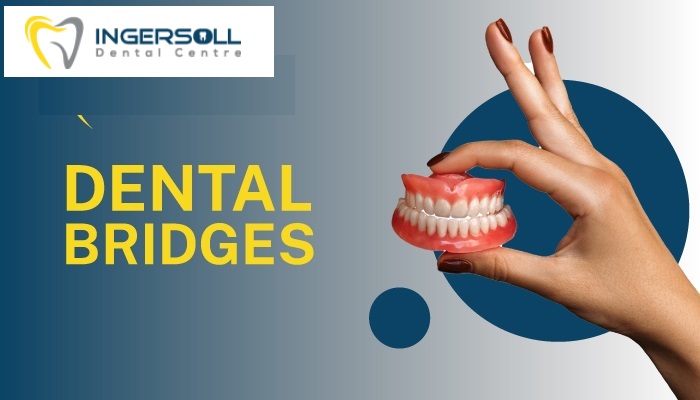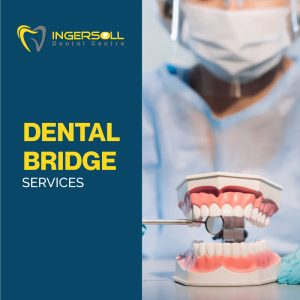Missing teeth can significantly influence your smile’s beauty and general health. It’s essential to understand the treatment choices available to you if you’re looking for a missing tooth solution. Knowing the treatment options will assist you in determining the best choice for you. If you need to replace one or more missing teeth, the dental bridge is a good option.
What is the dental bridge?
A dental bridge is a treatment in which a dentist replaces missing teeth with one or more artificial teeth made of resin or porcelain. A bridge is a device attached to crowns that anchor the device to natural teeth. It is also a filler, fake teeth, or partial denture. If you’ve lost one or more teeth, you may need a bridge. One or more crowns will fasten the bridge to prevent the adjacent teeth from sliding out of place. Dental Bridges are made using the materials like Gold, alloys, porcelain, or a combination of these natural teeth or dental implants to support dental bridges.
What is the process of placing dental bridges?
Your dentist will start preparing the anchor or abutment teeth after determining that a dental is an excellent option to replace your missing teeth. This initial therapy is usually carried out under local anesthetic, and it is not generally considered painful.
The bridge will be fitted during your second appointment. Your new dental bridge may feel bulky at first, but this should pass as you use the new prosthetic. Your dentist will examine the bridge and make changes if you feel any pain during the third and final follow-up exam.
What are the different Dental Bridge Services?
The dental bridge that will best suit you depends on the dentist’s recommendation. There is a variety of dental bridge services::
- Traditional Bridge consists of a crown on either the missing tooth or implant, with a pontic (fake tooth/teeth). Traditional bridges are porcelain fused to metal or ceramics and are the most famous bridge.
- Cantilever Bridge: When just one side of the lost tooth or teeth has adjacent teeth, a cantilever bridge is employed. It is no longer very prevalent, and it is not suggested near the back of the mouth, where it might cause harm to adjacent teeth by exerting too much force on them.
- Maryland bonded bridge: The teeth and gums of a Maryland bonded bridge (also known as a resin-bonded bridge or a Maryland bridge) are constructed of porcelain, porcelain fused to metal, or plastic.
- Implant-supported bridge: A traditional dental bridge is comparable to an implant-supported bridge. However, it is supported by implants rather than natural teeth. In most situations, one implant is inserted in the jawbone for each missing tooth when an implant-supported bridge is employed. The crowns are then joined together to make a single piece.
Benefits of Dental Bridges
-
Get Your Smile Back
You can’t place a price on a beautiful, healthy smile. Many patients report feeling more confident after receiving a dental bridge or other tooth replacement. A dental bridge for front teeth can significantly improve your quality of life by restoring your smile.
-
Chew Painlessly
You may have trouble eating your favorite meals after tooth loss. The shifting of neighboring teeth toward the free space might produce pain. Food particles can also accumulate in the empty socket where your tooth was extracted, causing gum injury.
We recommend dental bridge therapy to eliminate pain when eating permanently. Eating shouldn’t have to be a painful experience regularly. Make an appointment with a dentist who specializes in bridgework now.
-
Enhance Your Speech
You may have difficulties pronouncing some words or speaking with a lisp if you have lost many teeth. To correct these problems, you must first address the tooth loss that caused your speech to deteriorate in the first place. Your teeth are crucial in the formation of words in your mouth. A front tooth bridge may be beneficial.
-
Prevent Jawbone Degeneration
Did you realize that losing a tooth causes your jawbone to deteriorate? Tooth roots are present in the bone cells in your jawbone. Your jawbone starts to damage without this stimulation. Extreme jawbone degradation might result in more tooth loss and possibly facial collapse, altering your face’s form.
-
Prevent further tooth decay
Strong roots beneath the surface of your gums keep your teeth in place. However, did you realize that your teeth are also held in place by teeth nearby? Your remaining teeth may tilt toward the open gap after considerable tooth loss. The easiest way to avoid teeth moving is to replace the gap with an artificial tooth.
What is the cost of the Dental Bridge in Ontario?
The cost of a dental bridge varies significantly from one patient to the next. In Ontario, a dental bridge cost is around $800 to $1200+ with a standard insurance plan. A good ballpark number for a bridge without insurance would be around $2000 to $3000 and above.
What factors influence the price of a dental bridge?
Several factors can influence the cost of a dental bridge, including:
- The type of dental bridge you choose
- The total number of teeth required to close the gap
- Porcelain or noble metal is utilized to make false teeth.
- The placement’s complication
- Additional tooth-supporting treatments
What is the cost of the Dental Bridge in Ontario?
Here are some pricing estimates for dental bridges. An estimated cost of the dental bridge in Canada is given below:
- A classic or cantilever bridge ranges from $1,500 to $5,000.
- Bridges in Maryland typically cost between $1,500 and $2,500.
- An implant-supported bridge could cost $4,000 to $15,000
Want to know more?
Dentists at Ingersoll Dental Care are experienced and committed to helping people maintain optimum dental health. Whether you are considering dental bridges or want to replace an old bridge, we work for both. Call (519)485-49515 to learn more about the dental bridge services we provide.













Add Comment